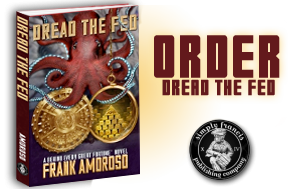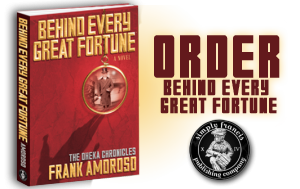‘Behind every great fortune,” wrote Balzac in “Pere Goriot,” “lies a great crime.”
Frank Amoroso of Wilmington took the first part of that motto for the title of his debut novel, a swashbuckling historical saga of international intrigue during World War I. Its star is an actual tycoon who’s widely regarded as the model for “Rich Uncle Moneybags” in the Monopoly game.
A former prosecutor and litigator in New York, Amoroso learned the story when he attended a social event at Oheka, an enormous mansion of Long Island’s Gold Coast.
“It’s an absolutely spectacular place,” he said.
It was there that he learned the story of Oheka’s builder, an investment banker, philanthropist and sometime yachtsman named Otto Hermann Kahn (1867-1934).
Almost forgotten today, Kahn was once a celebrity. Time magazine put him on its cover. The Marx Brothers spoofed him in “Animal Crackers.” Parker Bros. used his caricature as its Monopoly logo.
Amoroso thinks that Kahn’s grand parties at Oheka – an acronymn for his full name – might have partly inspired “The Great Gatsby.”
Kahn made a fortune as a partner in Kuhn, Loeb & Co. He was the longtime chairman of the board of the Metropolitan Opera. When Theodore Roosevelt ran for president in 1912, Kann helped bankroll his “Bull Moose” campaign.
Amoroso researched Kahn’s life and career for years – and noticed something.
“There have been three biographies of Kahn,” he said in a phone interview, said, “and all of them note that he and his wife spent three to four months of every year in Europe. I wondered, what was he doing over there? Nobody seems to know.”
The Kahn papers at Princeton University offered few clues.
Thus came Amoroso’s novel, “Behind Every Great Fortune™,” a speculation on what Kahn might have been up to in the course of World War I.
The convoluted tale involves events leading up to the Russian Revolution. Such real-life figures as Rasputin, Mata Hari, the ballet star Vaslav Nijinksy and Winston Churchill pop up in its pages.
Amoroso, who once taught a course on prosecuting white-collar crime, clearly has fun mapping out Kahn’s financial wheelings and dealings.
He credits his inspiration, in part, to a friend.
“The guy who wrote ‘Boardwalk Empire’ (lawyer-author Nelson Johnson) was best man at my wedding,” Amoroso said. “When I retired down here, he told me, ‘With all that time on your hands, you ought to write a book.’?”
Now, Amoroso thinks “Behind Every Great Fortune™” will be the first volume in a trilogy.
~Ben Steelman, StarNews
* * *
Frank Amoroso’s debut novel Behind Every Great Fortune ™ is a fictionalized view of the life of international investment banker Otto Kahn, and captures in exquisite detail the political intrigue ofthe early 20th century, including thhe vast cast of influential characters integral to the events leading to world wide conflagration. Incorporating glimpses into Kahn’s opulent and secretively hedonistic lifestyle, from the Gold Coast of Long Island’s Oheka Castle, to the offices, drawing rooms and boudoirs of the rich and famous of the time, Amoroso brings to life the “monopoly man” through his well written prose and extensive historical research.
~Anne Brusca, Library Media Specialist
* * *
Behind Every Great Fortune ™ is an exciting and imaginative novel with many scenes of high dramatic intensity.
~ Anonymous
* * *
“Because of my fascination with Russian history particularly during the time of the last Tsar – the book literally grabbed me in the first chapter and I could not put it down! The fact that a greedy self absorbed German American banker could weave a web of such deceit as to lay the twisted groundwork that led to WWI- what a totally intriguing prospect!
The characters were developed fully in their complexity through descriptive narrative and unbelievable mutual conversations! The author presents the possibility of many truths and un-imaginable scenarios! I can’t wait for volume 2!
Not only is the author’s knowledge and understanding of historical events fascinating but unprecedented as well! After all, history is gossip of the past that may or may not be true- the author certainly challenges the imagination of its validity!”
~Lindsay Edwards

















